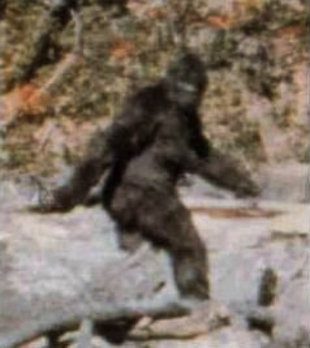I’m fascinated by UFOs, ghost-hunting, cryptozoology and all manner of paranormal phenomenon.
Well, actually, that’s not quite right — I’m fascinated by the people who are fascinated by those things.
That’s why I enjoyed Scott Poole’s Monsters in America: Our Historical Obsession with the Hideous and the Haunting, and why I’m intrigued by Gregory L. Reece’s Creatures of the Night. And it’s why I’m looking forward to seeing what comes of Syracuse University’s upcoming Religion Department conference on “The Monstrous, the Marginalized, and Transgressive Forms of ‘Humanity.’”
So I tend to collect links to the occasional stories that pop up on such topics.
 See, for example, the UFOs filmed over Denver, which Phil Plait disappointingly notes can be identified as, well, bugs. (If you don’t trust Plait because he’s a respected member of the scientific establishment conspiring in the Big Coverup, note that the Rocky Mountain Paranormal Research Society came to the same conclusion.)
See, for example, the UFOs filmed over Denver, which Phil Plait disappointingly notes can be identified as, well, bugs. (If you don’t trust Plait because he’s a respected member of the scientific establishment conspiring in the Big Coverup, note that the Rocky Mountain Paranormal Research Society came to the same conclusion.)
At Ars Technica, Nate Anderson rounds up a host of similar recent stories. There’s the North Korean “unicorn lair.” And the warnings of an ancient vampire on the loose in Zarozje, Serbia (who seems to be selling his old mirrors in the classifieds). And then there’s the Russian expedition that claims to have found Yeti fur in a Siberian cave. And the report of the chupacabra (and/or really big coyote) shot by a hunter in Missouri.
My favorite of this recent crop of stories has to be the one about the lab that says it has successfully sequenced the DNA of Sasquatch. It’s a Texas firm claiming this, so Charles Kuffner is on the story, linking us to SciGuy blogger Eric Berger, who notes that the lab “makes no mention whatsoever of the source of DNA for this study.”
Berger learns that the Bigfoot DNA for this study may have been collected from a merry band of Bigfoots (Bigfeet?) in Michigan who have a fondness for blueberry bagels. And that Sasquatch DNA also apparently includes DNA from angels. (I expect Deane Galbraith to weigh in soon on the theological implications of this discovery.)
This story is good for a laugh, but I don’t find the earnest delirium of these Texas Bigfoot hunters quite as ridiculous as most of the people who are just as obsessed with imaginary monsters.
As the name of that Syracuse conference suggests, the obsession with imaginary monsters is often a function of marginalizing and othering those we wish to view as monstrous. We distort those who disagree with us until they seem grotesque and evil — Satanazis, or Satanic baby-killers, or servants of Nicolae Carpathia.
But cryptozoologists are, I think, a different animal. They seem driven not by fear of the other, but by a desire for wonder. And wonder in itself is a Good Thing.
There is some overlap here between the religious demagogues demonizing their opponents as Satanic baby-killers and the cryptozoologists in search of Bigfoot. For whatever reason, both groups have found their lives in need of fantastic embellishment. Real life grounded in reality doesn’t seem to be enough. They’re looking for excitement, for cheap thrills — cheaper, at any rate, then the thrills reality offers, which tend to result from real work and real accomplishments. These are both fantasies that offer a shortcut to excitement and to happiness (or, rather, to a titillating substitute for happiness which might seem preferable to its apparent absence).
In both cases, this is kind of sad.
It’s sad to be chasing after imaginary sources of wonder when the universe is overflowing with so many actual sources of it. And it’s sad to become obsessed with battling imaginary evils when the world is overflowing with so many actual injustices.
And it’s sad that both groups seem to have wrapped themselves in cocoons of lies that they do their very best to pretend to believe. Those lies take more and more work to sustain, ultimately involving more labor and drudgery than whatever it was in the real world they were first fabricated to escape. That seems exhausting.
Still, though, as ridiculous as the Bigfoot-DNA-sequencers of Texas may be, I prefer them over the 38 Republican senators who voted last week to block the UN Convention on the Rights of Disabled People. Those votes were cast because of imaginary monsters — because of mythical links to the Satanic baby-killer abortionists and because of fears of an “Antichrist” based on Fortean eschatology. U.S. senators are powerful people and their actions can have powerful consequences. When those actions are motivated by fear of the monstrous and the marginalized, then real people wind up getting hurt.
Those 38 senators are bigger fools than the cryptozoologists feeding blueberry bagels to Bigfoot. And they’re far more dangerous.










